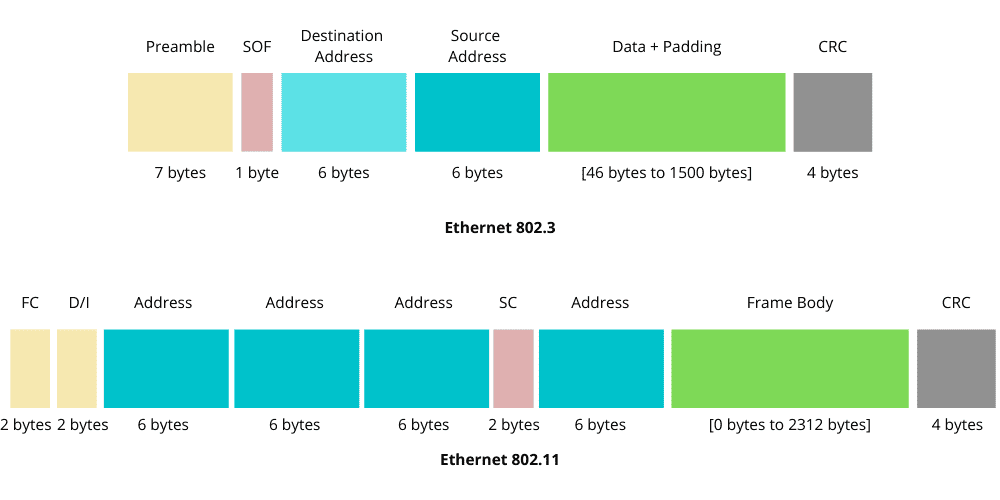1. 引言
OSI(Open System Interconnection)模型是一个标准化的框架,用于描述计算机在网络上的通信过程。它通过分层结构,使得在不同网络环境下、使用不同协议的设备能够实现通信。
正因为如此,数据在不同层级中的表现形式也不同。本文将重点介绍两个关键概念:数据包(Packet) 与 帧(Frame),它们分别属于 OSI 模型中的不同层级,是不同层的数据传输单位。
我们先分别了解什么是数据包和帧,然后再分析它们之间的主要区别。
2. 数据包(Packet)
✅ 数据包是网络层(OSI 第三层)的数据传输单位。
网络层从传输层接收数据段(Segment),并对其进行封装。其主要任务是将这些数据包转发到不同网络中的路由器,以实现跨网络的通信。
✅ 数据包的源地址和目的地址都是逻辑地址。 因此,其头部(Header)中包含的是源和目标的 IP 地址。
在互联网中,TCP/IP 模型中的 Internet Protocol(IP)与 OSI 模型的网络层相对应。路由器正是根据 IP 包头部中的 IP 地址 来决定如何转发数据包的。
如下图所示是一个典型的 IP 数据包结构:

3. 帧(Frame)
✅ 帧是数据链路层(OSI 第二层)的数据传输单位。
数据链路层将从网络层接收到的数据包进一步封装,加上自己的头部(Header)和尾部(Trailer),最终形成一个帧。因此,帧中包含了一个数据包作为其有效载荷(Payload)。
✅ 帧的源和目的地址是物理地址(MAC 地址)。所以其头部中包含的是源和目标的 MAC 地址。
由于数据链路层从物理层接收的是比特流(Bits),它的主要任务是确保数据的无误传输。因此,它会在帧的尾部加入 帧校验序列(Frame Check Sequence, FCS) 用于错误检测。此外,还会使用标志位(Flags)来标识帧的开始和结束。
以以太网(Ethernet)为例,它是 TCP/IP 中最常用的协议之一,与 OSI 模型的数据链路层相对应。一个典型的以太网帧结构如下:

4. 数据包与帧的区别
为了更清晰地理解两者的不同,我们来做一个简明对比:
| 特性 | 帧(Frame) | 数据包(Packet) |
|---|---|---|
| 所属 OSI 层 | 数据链路层(Layer 2) | 网络层(Layer 3) |
| 地址类型 | 物理地址(MAC) | 逻辑地址(IP) |
| 包含内容 | 数据链路层头 + 数据包 + 尾部(Trailer) | 网络层头 + 传输层段 |
| 是否包含尾部 | ✅ 是(用于错误校验) | ❌ 否 |
| 数据封装关系 | 封装了数据包 | 被封装在帧中 |
| 主要用途 | 在本地网络中传输数据 | 在网络间路由数据 |
⚠️ 最关键的区别是它们所处的 OSI 层级不同:帧属于数据链路层,负责本地网络通信;而数据包属于网络层,负责跨网络的路由。
5. 总结
本文我们介绍了 OSI 模型中的两个核心概念:数据包 和 帧。
- 数据包是网络层的传输单位,使用逻辑地址(IP)进行寻址。
- 帧是数据链路层的传输单位,使用物理地址(MAC)进行寻址。
- 帧封装了数据包,并添加了错误校验信息(Trailer)。
- 数据包负责跨网络的路由,帧负责本地网络的传输。
理解这两个概念及其区别,有助于更深入地掌握网络通信的底层机制,尤其在排查网络故障或优化性能时非常有帮助。